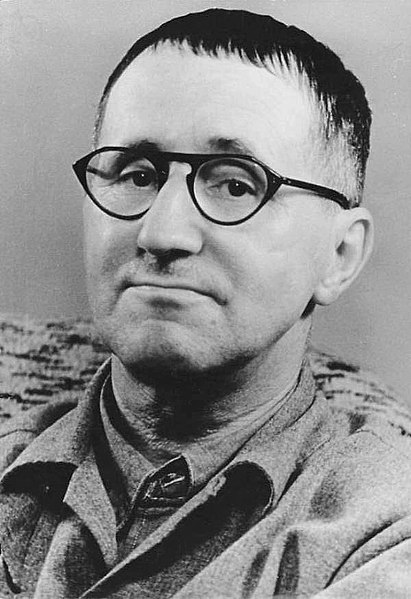 Bio Of Brecht!
Bio Of Brecht!Playwright Eugene Berthold Brecht (also known as Bertolt Brecht) was deeply influenced by Charlie Chaplin and Karl Marx. This strange combination of inspiration produced Brecht’s twisted sense of humor as well as the political beliefs within his plays.
He was raised in a middle class family in Germany, although he often fabricated stories of an impoverished childhood. As a young man, he was attracted to fellow artists, actors, cabaret musicians, and clowns. As he began to write plays of his own, he discovered that the Theatre was the perfect forum to express social and political criticism.
Brecht developed a style known as “Epic Theatre.” In this medium, actors did not strive to make their characters realistic. Instead, each character represented a different side of an argument. Brecht’s “Epic Theatre” presented multiple viewpoints and then let the audience decide for themselves.
Does this mean Brecht didn’t play favorites? Certainly not. His dramatic works blatantly condemn fascism, but they also endorse communism as an acceptable form of government. His political views developed from his life experiences. Brecht fled Nazi Germany before the onset of World WarII. After the war, he willingly moved to Soviet-occupied East Germany and became a proponent of the communist regime.
Brecht's Major Play!
His most acclaimed work is Mother Courage and Her Children. Although set in the 1600s, the play is relevant to contemporary society. It is often regarded as one of the finest anti-war plays.
Not surprisingly, Mother Courage and Her Children has frequently been revived in recent years. Many colleges and professional theaters have produced the show, perhaps to express their views on modern day warfare.
The one the play’s most renowned lines is: "Who is the bigger criminal: he who robs a bank or he who founds one?"
Epic vs Dramatic Theatre!
| Dramatic Theatre | Epic Theatre |
| Plot | Narrative |
| Implicates the spectator in a stage situation | Turns the spectator into an observer |
| Wears down his capacity for action | Arouses his capacity for action |
| Provides him with sensations | Forces him to take decisions |
| Experience | Picture of the world |
| The spectator is involved in something | He is made to face something |
| Suggestion | Argument |
| Instinctive feelings are preserved | Brought to the point of recognition |
| The spectator is in the thick of it, shares the experience | The spectator stands outside, studies |
| The human being is taken for granted | The human being is the object of the enquiry |
| He is unalterable | He is alterable and able to alter |
| Eyes on the finish | Eyes on the course |
| One scene makes another | Each scene for itself |
| Growth | Montage |
| Linear development | In curves |
| Evolutionary determinism | Jumps |
| Man as a fixed point | Man as a process |
| Thought determines being | Social being determines thought |
| Feeling | Reason |
Above i have found a table giving the differences between dramatic and epic theatre i found this table on: http://www.usq.edu.au/artsworx/schoolresources/3pennynotes/drama
Verfremdungseffekt
Often translated as the ‘alienation effect’, verfremdungseffekt is better explained as the ‘making strange effect’, or the ‘defamiliarisation effect’. ‘Alienation’ implies that the audience is disconnected completely from the performance, which is not quite correct. While they are disconnected from empathizing with the characters and their plight, as in naturalistic theatre, they are still completely involved in critically-analysing the play and its broader social significance. The ‘V-effekt’ is a technique of taking human social incidents and labelling them as something striking, something that calls for explanation, something not to be taken for granted, not just natural.
Gestus
Gestus, Brecht said, was the base building block of Epic Theatre. It is both gist and gesture; an attitude expressible in words and actions (Chalk). A basic equation for gestus is: a gesture of the body (gest) + a message (gist) = gestus (Chalk). The message is an essential part of this equation, because without a broader social context, the gesture is redundant. The most famous example of this particular element is from the original production of Mother Courage and Her Children. In the scene where Mother Courage’s son is killed, she lifts her head back, stretches her mouth wide, and holds this grotesque position in a “silent scream”. This showed her devastation at the loss of her son, but her inability to show that feeling. So the physicality of the scream + her contradictory feelings = the gestus of the ‘silent scream’.
Music
The “V-effekt” was also made possible in Epic Theatre with help from the music. In many of Brecht’s plays where music was used, the musicians were set up where they could be seen. In the original Berlin production of The Threepenny Opera, the titles of the songs were projected on placards on stage, the orchestra was lit up, and the actors changed position in order to sing their songs. This is just another way of showing that it is just a theatre show, that the actors are simply actors and that the musicians were just that, musicians.


